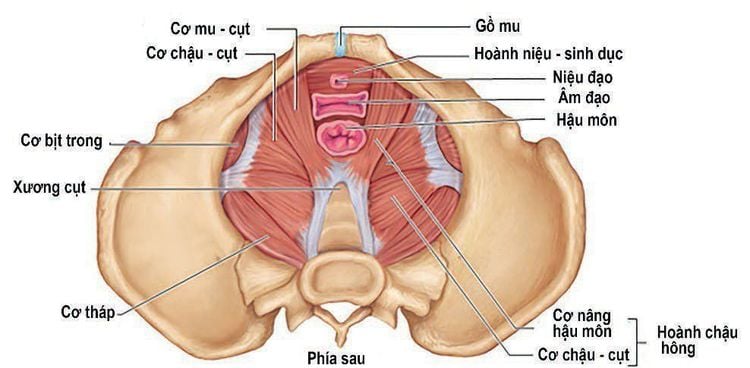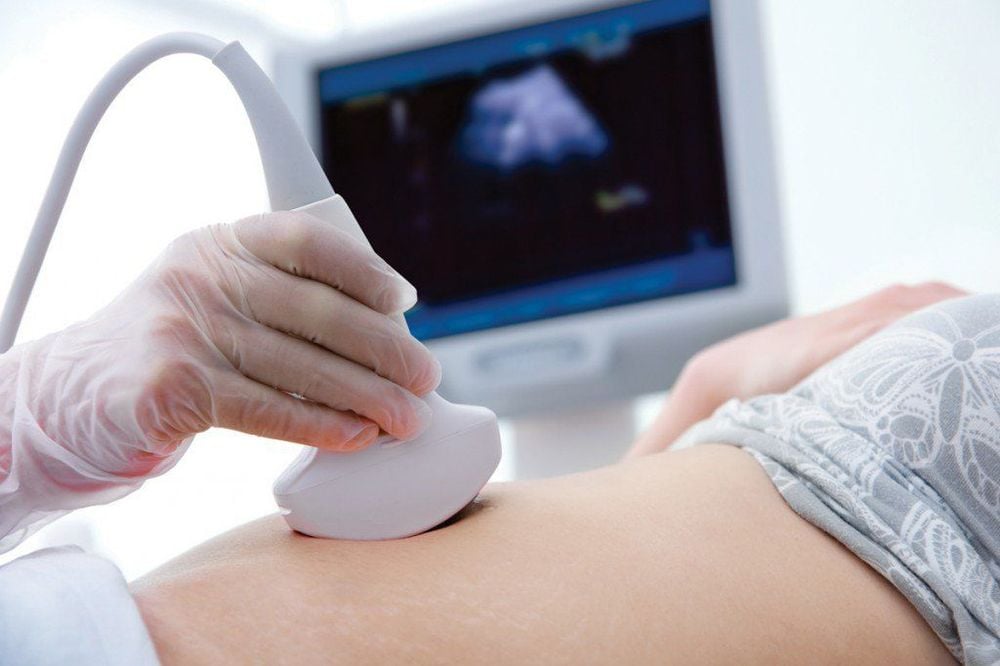This is an automatically translated article.
This article is professionally consulted by: Doctor Nguyen Chi Quang, Obstetrician and Gynecologist, Vinmec Central Park General Hospital. The doctor has many years of experience in the field of obstetrics and gynecology.The pelvic floor plays a role in helping a woman's digestive, urinary and reproductive organs work properly. Postpartum women should have a physical examination, assess function, examine the pelvic floor to prevent pelvic organ prolapse, and be counseled on postpartum pelvic floor dysfunction in a timely manner.
1. Women's pelvic floor
The pelvic floor is likened to a hammock formed from many interlocking fascia and muscles, this fascia and muscle mass firmly adheres to the front of the abdomen and pubic bone, the two sides are the hip bones, the back is the spine. waist down to the sacrum.
The pelvic floor is the totality of 3 systems: the genitourinary system (uterus, vagina), the lower urinary system (bladder, urethra), the lower digestive system (rectum, anus). The pelvic floor also contains many vascular and nervous systems.

2. What is a pelvic floor exam?
Many women, when experiencing unusual problems around the pelvic floor and genitals, feel shy and hesitant to go to the doctor.However, for pelvic floor problems, if left for a long time, it will be difficult to treat, especially can lead to severe uterine prolapse, cause ulcers, and dangerous complications. surgical removal of the uterus. Therefore, as soon as there is a strange phenomenon, women should go to the doctor to detect the disease early, then receive advice and treatment with appropriate methods.
Contents of postpartum pelvic floor examination 2.1.1. Posture to examine the pelvic floor Examination position such as a gynecological examination or a lying down position, with the head elevated 45 degrees. The patient pushes during the assessment and examination. The doctor can perform cervical traction with pozzi or cardiac forceps 2.1.2. Neurological examination of the pelvic floor Acoustical region When contracting the pelvic floor muscles When coughing, do you leak urine or see hemorrhoids? Assess pelvic floor node S2-S4 reflex, knee reflex, skin roll, signs of sacroiliac or spondylolisthesis. 2.1.3. Vaginal examination Where is the pain or numbness noted? Assess perineal muscle tone at rest? Assess pelvic muscle strength, whether there is damage or tear of muscle fascia or not? Evaluation of pelvic organ prolapse according to the POP-Q . classification

3. So what is pelvic floor examination?
3.1.1. General examination About 4-6 weeks postpartum, women should have a postpartum examination. A general examination of pregnant women is carried out, from weight check, after breast examination, then vaginal examination, pelvic floor examination, and screening tests for cervical cancer, measurement and follow-up. monitor blood pressure, blood sugar analysis test if there are pathologies during pregnancy: preeclampsia, gestational diabetes...
3.1.2. Counseling Nutrition counseling: Nutrition for women after giving birth to strengthen the pelvic floor muscles to be elastic... Contraceptive counseling: Every pregnancy, regardless of gestational age, pelvic muscles will also change according to women's internal hormones, many changes will cause pelvic floor dysfunction. 3.1.3. Evaluation of pelvic floor function The doctor will conduct a record: Assess pelvic floor function
First, ask the patient and examine: You need to answer the medical staff's questions related to the symptoms of the disorder. Pelvic floor muscle dysfunction includes: abnormal signs of urination and defecation before and after birth, diseases acquired before and after birth, methods of delivery, baby weight... The doctor will perform an examination and evaluation on the results of the wound at the vulva, evaluate the problem of the pelvic floor, and especially the physical strength and muscle strength of the pelvic floor, from which to develop a regimen, treatment approach tailored to each individual.
Then, depending on the condition you encounter, the doctor will appoint specialized tests such as:
Abdominal ultrasound

Pelvic floor electromyography, 15 minutes Guide to keeping a urine diary for 2 days. Urine test. Urodynamic measurement, 30 min. Dynamic MRI of the abdomen and pelvis, when organ prolapse is accompanied by persistent constipation. Ultrasound of the anal sphincter Depending on the severity of the disease, you will be consulted for treatment, either medically with physical therapy or surgery.
Consultation for treatment of pelvic floor dysfunction
After visiting the doctor and medical staff will advise you on the next treatment plan. Voluntary gynecological examination will provide you with the right solutions: Postpartum exercise instructions, pelvic floor exercises.
4. People who need a pelvic floor exam
Postpartum pelvic floor examination for pregnant women who have given birth many times, after giving birth with symptoms of urinary incontinence, air leakage, fecal incontinence, failure to urinate as desired, need to be consulted for pelvic floor muscle training.
Women between the ages of 40 and 60 who present with pelvic floor dysfunction and pelvic organ prolapse should have an annual gynecological examination, and pelvic floor dysfunction evaluation for advice and treatment. treat. Women entering menopause experience hormone deficiency, sex hormone disorders
5. What symptoms should you see a pelvic floor examination?
Many women don't notice or experience specific symptoms because they don't see any difficulty with pelvic organ prolapse. And most women see this change from mild to severe. Specifically, the clinical symptoms may be as follows:
Lower urinary tract: Urinary incontinence, increased frequency of urination, weak or prolonged urine stream, hesitancy, feeling of incomplete voiding, need to urinate. must act to bring the internal organs back into the vagina to be able to urinate or defecate. Pelvic organ prolapse: Vaginal bulging sensation, pressure and heaviness in the pelvic floor and vagina, seeing or palpating a vaginal or pelvic floor bulge; Using tampons also becomes difficult. Sexual disorders: Painful, shallow, deep, hindered sexual intercourse, decreased libido, wide vagina. Anorectal disorders: Incontinence, or urgency, urinary urgency, incontinence, defecation, feeling of incomplete defecation, constipation, decreased rectal sensation, appearance of substances Mucus discharge from the rectum, rectal bleeding. Pain in the urinary tract and pelvic organs: pain in the bladder, urethra; pain in the vulva, vagina, perineum; pelvic pain (may be cyclical) groin pain; lower back pain; Tension or pain in the lower abdomen or around the pelvis.

6. Where should I go for a pelvic floor exam?
Vinmec International General Hospital is one of the leading prestigious medical centers for reproductive health. Doctors conduct pelvic floor examination after birth according to professional standards, safe, with modern and synchronous equipment; spacious and clean infrastructure; especially a team of qualified and experienced doctors. Pelvic floor examination is one of the steps that Vinmec International General Hospital requires for any woman entering childbirth.Currently, at the Hospital, we are implementing the BASIC Gynecological Examination and Screening Package, helping customers detect inflammatory diseases early, so that the treatment process will be easy and inexpensive. Screening can also detect early gynecological cancer (cervical cancer) even if there are no symptoms.
If you have any questions, please come directly to the hospital or contact HERE to be answered by specialist doctors.
Postpartum pelvic floor examination is necessary for women, especially women who give birth vaginally. Postpartum pelvic floor examination helps women understand their own health situation and get timely treatment if problems occur.
Please dial HOTLINE for more information or register for an appointment HERE. Download MyVinmec app to make appointments faster and to manage your bookings easily.














